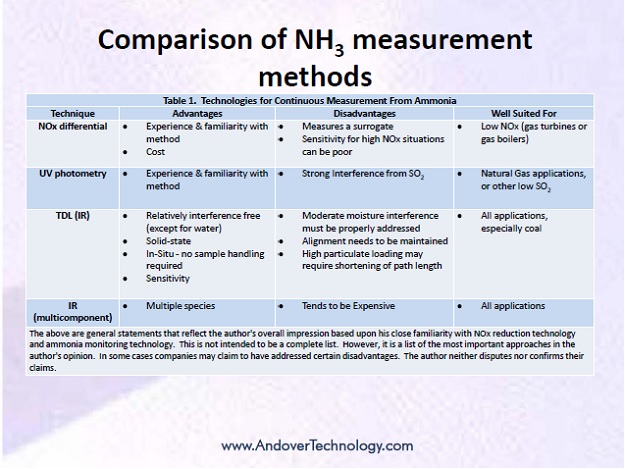WEBINAR EXAMPLE
Measurement of Gas Turbine Emissions including NH3 was Hot Topic Hour on April 17
A good discussion of gas turbine emissions measurement, including particulates, condensibles, NH3, NOx and in the case of oil-firing, SO2. The meeting started with an explanation of the “discussion” concept.
McIlvaine has a whole new format with dedicated websites that are free to everyone and then webinars which are free to owner/operators. The webinars are in a discussion format with the background information on the website displayed as the subjects are discussed. Initial comments are made by discussion leaders followed by group participation.
One of the subjects that received the most attention was analysis of ammonia slip. Jeremy Whorton of ThermoFisher made a strong case for the use of the NOx differential approach. Jim Staudt of Andover Technologies listed this as one of four major options but pointed out that where the NOx to NH3 ratio is quite high the differential approach is inaccurate. He believes the TDL has advantages where high sulfur oil is being used. Tom McKarns of ECO Physics pointed out that FTIR can measure NH3 along with a number of other gases.

Particulate was addressed by Glen England, Environ who pointed out some of the challenges in measuring total particulate including condensibles. The methods that are stipulated by regulatory agencies are indicating much larger quantities than what is actually being discharged. Len Richter indicated that CISCO is involved in a number of international projects where oil is being fired. This creates an additional challenge. CISCO first became involved with the ammonia slip problem many years ago with a CEM system for a biomass boiler. Another relative application is landfill gas which is now a growing application for gas turbines.
All the power points and background data from this discussion are posted at Gas Turbine Emission Control—Continuous Analysis. Following are some of the links.
There is a comparison of NOx differential, UV photometry, TDL and IR as options for NH3 measurement. Successful control of SNCR and TDL is chronicled.
- EPA Methods 201A & 202 (& similar methods) remain problematic for gas-fired sources
—Lack sufficient sensitivity
—Blank levels are significant – not due to reagent contamination!
—New Method 202 reduces but doesn’t eliminate artifacts.
- Dilution methods offer advantages for gas-fired sources.
—Greater accuracy due to absence of SO2 and VOC artifacts and greater analytical sensitivity.
—Resulting PM2.5 emission factors are ~1/10 or lower of those based on hot filter/cooled impinger methods e.g., AP-42.
Revision Date: 4/17/2014
Tags: 221112 - Fossil Fuel 化石燃料, 221112 - Fossil Fuel 化石燃料, Andover Technology Partners, Tunable Diode Laser Sp
EPA Methods 201A and 202 (and similar methods) remain problematic for gas-fired sources. Dilution methods offer advantages for gas-fired sources.
Revision Date: 4/17/2014
Tags: 221112 - Fossil Fuel 化石燃料, Environ International, Particulate, PM 2.5, Condensibles
FTIR can measure NH3 along with a number of other gases. Advantages include long laser life, no liquid N2 required, no sample pressure restrictions, easy to maintain, makes repetitive tasks easier.
Revision Date: 4/17/2014
Tags: 221112 - Fossil Fuel 化石燃料, California Analytical Instruments, FTIR, Continuous Emissions Monitor, NOx Analyzer, NH3 Analyzer
CEMS for Calabas Landfill Gas CEMS by Len Richter, Cisco - Hot Topic Hour April 17, 2014
Cilsco supplied the CEMS for this California land fill gas project which uses Solar Turbines. NOx is 7 ppm and CO is 3 ppm
Revision Date: 4/15/2014
Tags: 562212 - Solid Waste Landfill, 221118 - Other Electric Power, Cisco, Solar Turbines, Continuous Emissions Monitor, Solar Turbine, Continuous Emissions Monitor, NOx Analyzer
Predictive Emissions Monitoring is an option for gas turbine NOx measurement
Thomas Eisenmann, Durag is presenting a paper at CEM 2014 which explains why predictive monitoring is an option for the primary monitoring of gas turbines and duct burners or as a secondary measurement tool. PEMS offer significant cost benefits with lower capital expenditures as well as much lower operational and maintenance cost than CEMS. PEMS and DAHS require for operation very little or no plant manpower. CEM 2014 - The 11th International Conference and Exhibition on Emissions Monitoring will take place in Turkey in the country’s financial and cultural capital, Istanbul, from the 14th – 16th May 2014.
Revision Date: 4/14/2014
The entire April 17 recording can be heard at:
Measurement of Gas Turbine Emissions Including NH3 95 minutes
You will need to enter your name and email address after clicking link to view recording.



